
How to use email marketing to create campaigns and connect with your users
Main illustration: Olenka Malarecka
Email is one of the most effective channels that a business can use to reach its customers.
You might think we’re all about live chat here at Intercom, but we’re true believers in building relationships with users no matter the medium.
Email marketing remains an incredibly valuable way of communicating with customers at every stage of their lifecycle, whether you’re a thriving SaaS company or up-and-coming small business. But as I’ve learned over the years managing marketing campaigns here at Intercom, there’s more to email marketing than simply clicking “Send.”
If you’re just getting started with email marketing for your business, here’s how you can make sure the email campaigns you send are successful every time.
What is email marketing?
Plain and simple, email marketing is the tactic of sending marketing messages via email. Pretty straightforward, right?
What might surprise you is just how much of the email you receive is a form of marketing. The retail sales emails are obvious, but email marketing also includes things like:
- Review reminders for recent purchases
- Recommendations for similar products
- Onboarding tips for a new app
- “Come back” campaigns for inactive users
If the goal of an email is to get a customer to take action, it’s marketing.
Why email marketing isn’t going away
Every now and then, a marketer will publish a blog post claiming email marketing is dead, usually shortly after the creation of a popular new tool or social media network.
However:
When people say “X is dead” remind them that Elvis made $55M last year.
— Startup L. Jackson (@StartupLJackson) May 17, 2014
Despite claims to the contrary, emails remain incredibly effective at motivating all sorts of behaviors.
As of right now, there are about 3.8 billion email users worldwide, about half of the world’s population. Researchers predict that by 2022, each user will have close to two email accounts, as more people get a work-only email address.
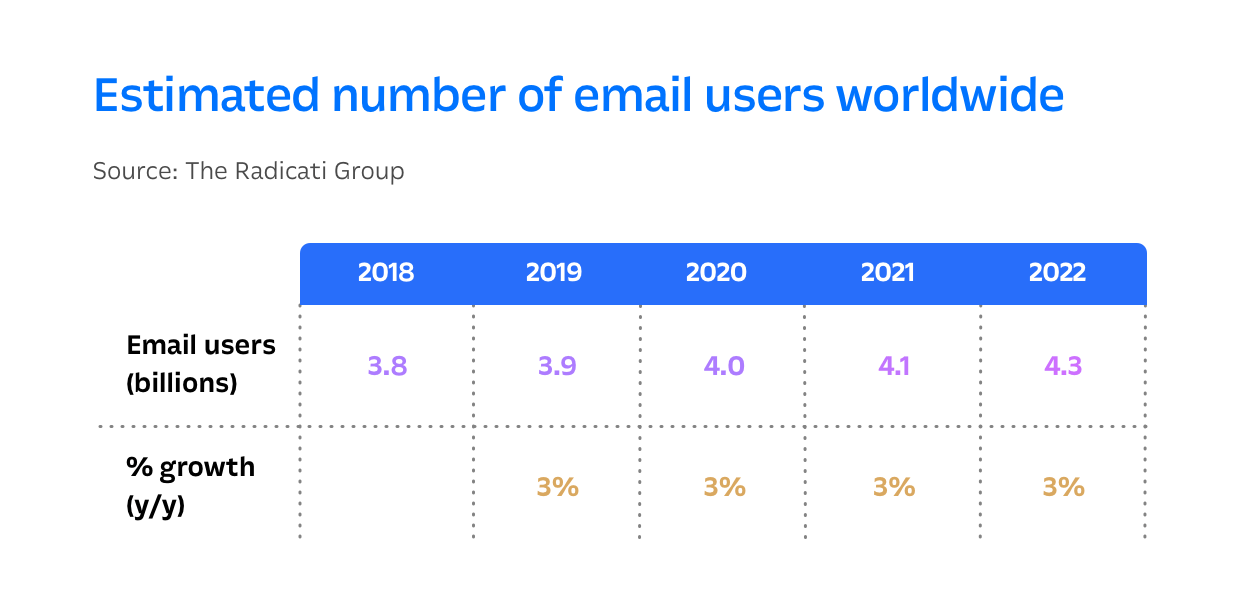
Email marketers claim an average ROI of about $38 per dollar spent, making it one of the most profitable marketing activities available.
With these growing numbers, email is proving to be a resilient and reliable channel for reaching customers and motivating them to take action. The high potential for profit doesn’t hurt, either.
How to get started with email marketing
So if you’re not yet using email marketing, here’s a quick five-step list to help you set up your email list, send your first emails, and scale up your activity to reach as many customers as possible.
1. Choose an email marketing service
The first step to take is to find an email marketing service that has the features you need to interact with your customers. Intercom could be a great starting point especially if you also plan to send in-app messages or use live chat for sales or support.
2. Create a signup form
Once you’ve decided which email marketing service to use, add at least one prominent signup form on your website – on your homepage, on your blog, at checkout, or all three – to start building your email list.
You may not necessarily be using your email list just yet, but by adding at least one signup form, you’ll be able to start collecting customers’ contact info well in advance of your first campaign.
3. Grow your subscriber list
Prompt people to sign up for your emails in the other channels you’re using for communication: social media, live chat, in-app notifications, etc.
In particular, consider the touchpoints in the customer lifecycle where you’re losing leads or customers. Email can be a great tool to fill in gaps between conversion points. For instance, if you spend a lot of time on content marketing to attract top-of-funnel leads, an email newsletter sign-up prompt can motivate them to come back to your site regularly and shorten the time to conversion.
“Email can be a great tool to fill in gaps between conversion points”
By prompting people to sign up via your website and other touchpoints, you’ll be able to funnel new leads and customers into your campaigns on an ongoing basis. As your list grows from these multiple sources, you’ll be able to create new segments and campaigns to better meet their individual needs.
4. Create basic email campaigns
It’s time to start sending emails! The first thing to do is to establish a regular cadence. This can be weekly, monthly, or bimonthly. Your constant presence in inboxes isn’t critical, as long as you follow a schedule.
Here are some common starter email campaigns:
- A newsletter. You can fill it with links to your articles, new product news, company announcements, or all three. Parse.ly found that compared to non-readers, newsletter readers are more likely to spend more time and money on a company site. They are also more likely to consume content or upgrade their plan.
- An onboarding email series. If you have a SaaS business, onboarding emails can welcome new users to your product and educate them on its use. They’ll keep users engaged and coming back to your product during those critical early days when churn is highest.
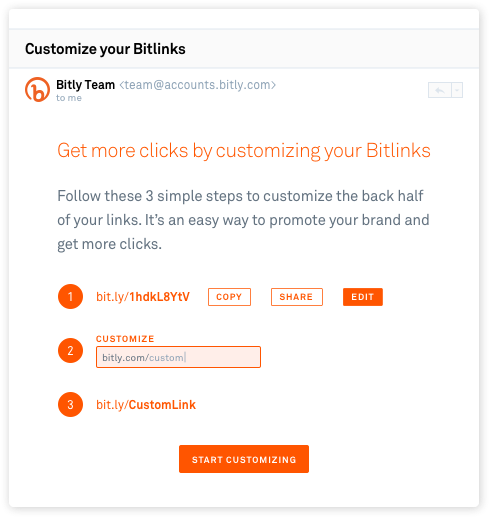
- Product setup emails. If you sell physical products, you might think about a similar series of emails showing customers how to set your product up or use it in different ways. You could even send an FAQ email timed to arrive just before the product does, so that a customer’s first few questions are answered without them ever needing to visit your site.
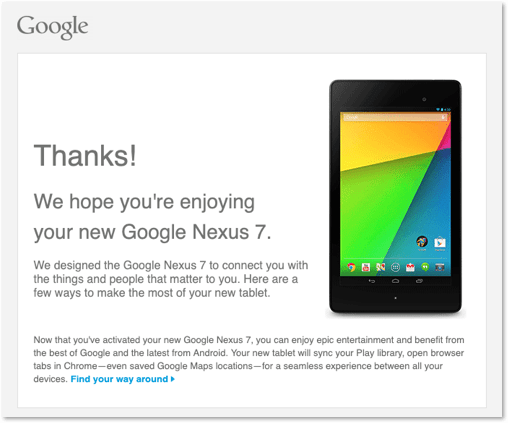
5. Add additional emails based on customer segments
The final step of your plan should be to develop additional emails that drive deeper engagement and retention from your most valuable prospects and customers.
A good way to do this is to segment your list based on activity, interest, plan, or other unique factors. This way, you can create more personalized emails for each group – and the more personalized the message, the more likely they are to be acted on.
A few ideas:
- Send re-activation messages to customers who might be at risk for churn (for example, if they haven’t logged in for a week). Simply asking if they need help or offering a quick tip might bring them back.
- Send emails about related products to customers who have purchased a specific product in the past.
- Invite prospects to specific webinars tailored to their roles or industry.
Here are some of the emails we send at Intercom:
- A weekly newsletter about the latest articles on the blog
- Product launch announcements
- Promotions for upcoming webinars, events and other new resources, like our books
- Follow-up emails after webinars and events promoting related resources
- Automated follow-up emails with our long-tail sales leads
- Prospect nurture emails personalized by segment and intent
- Onboarding emails
The 5 components of a successful email marketing campaign
Now that you’re gathering some ideas for your own campaigns, let’s discuss how to get more of your emails opened, read and acted on.
Here are a few key components that, once tackled, will set your email campaigns up for success.
1. Ideal timing
Poorly timed emails are usually ignored or deleted. All that hard work, gone in an instant.
Plenty of research has been done on how send times affect open rates in different industries. As one example, ecommerce emails are opened slightly more than average on weekends.
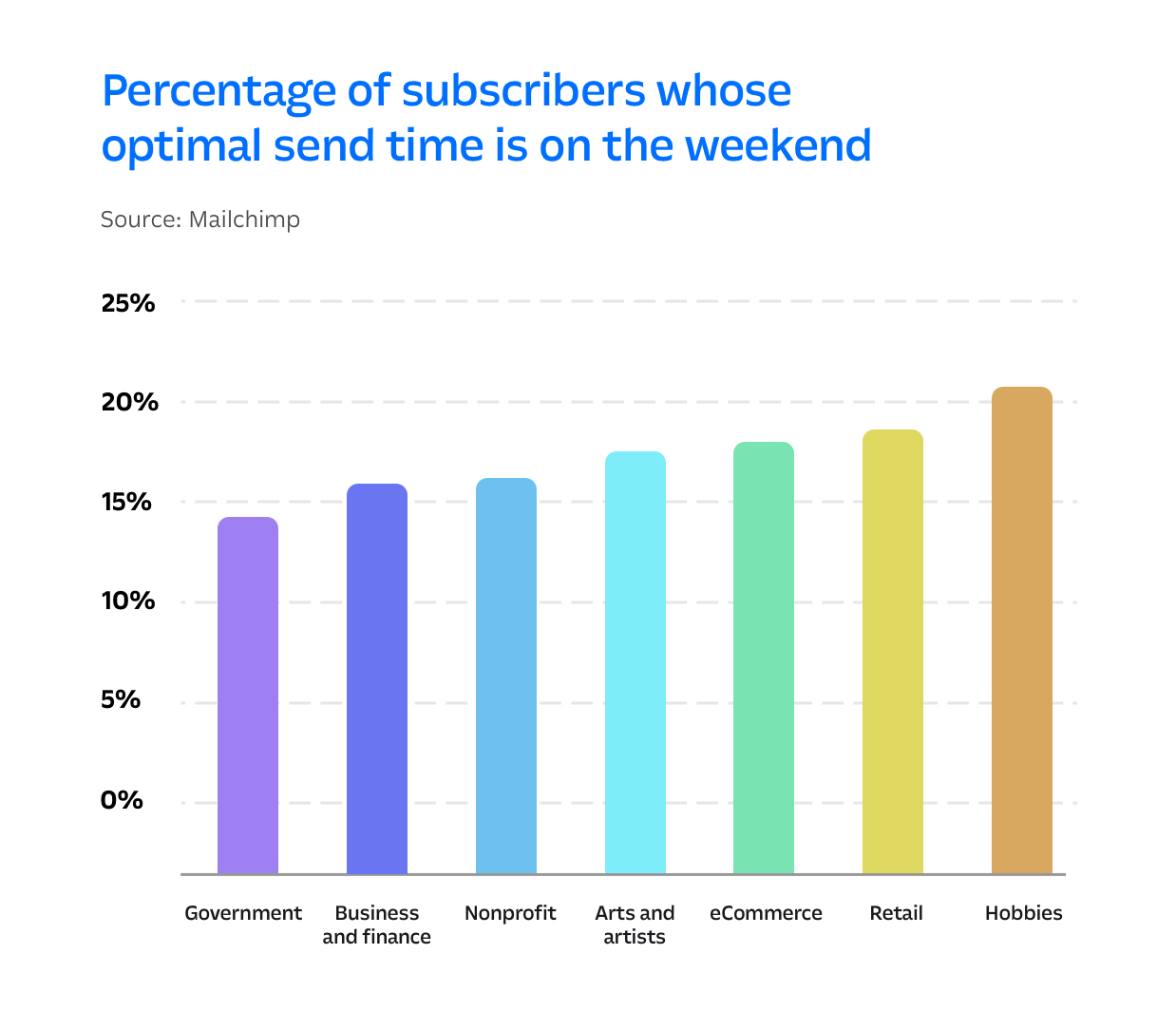
You can also make intuitive decisions about timing based on what you already know about your customers. Think about when they work, how they live, when, and how they’re most likely to check their email. Then tailor your send times to match. For example:
- If your leads are frequent travelers, the best time to catch them might be early in the day or late afternoon, while they’re waiting for a flight or train.
- If your ideal customer is a working professional, they might be more likely to open your emails during their lunch hour or after work.
- If you’re selling a meal delivery service, you might tempt a hungry shopper to convert around lunchtime or just before dinner.
Ultimately, the best way to find the right timing is with testing. Start sending emails based on what you know and make plans to A/B test additional days or times as you move forward (just as you would with a landing page).
2. A clear subject line
Even if your email arrives at the ideal time, your customers might take one look at the subject line and instantly decide it’s irrelevant.
So make your subject lines clear and direct. As Mailchimp says, the approach of “tell, don’t sell” tends to net the most opens.
This is a direct subject line: Hot deals for your next flight
This isn’t: Celebrate comfort, tradition and adventure with your next flight
The first subject line tells me that I can save some money for my next trip. The second just makes me wonder what I’m celebrating. And why am I celebrating?
If you’re not certain about what might resonate best with your audience or how your subject line will actually look in your customers’ inboxes, my advice is to test, test, test. Run A/B tests, use subject line grading tools and use your email service’s own testing and preview options to check your results in as many real inboxes as possible.
3. Personalized messaging
If someone yells “Hey, you!” in a crowded public place, you’re not likely to react. But if someone shouts your first name, you’ll probably turn your head, right?
We saw the power of personalization firsthand here at Intercom. When our sales team added personalized videos to their emails, replies increased by 52%. Similarly, Campaign Monitor found that personalizing subject lines made people 26% more likely to open the email.
“When our sales team added personalized videos to their emails, replies increased by 52%”
The personalization you use in your emails doesn’t have to be dramatic, especially when you’re just getting started. Simply adding your customer’s first name to the subject line or opening can improve engagement.
As your business grows, consider triggering specific emails based on what a customer purchased, when they purchased it, when they last visited their site or what they expressed interest in.
In the example below, a reader who’s shown their interest in author Stephen King by “following” him on Amazon received an automated email when his newest novel was released:
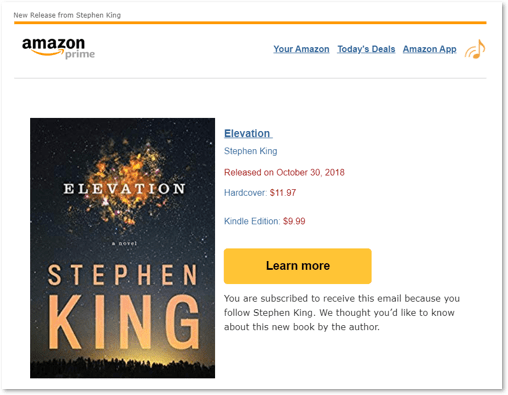
When done thoughtfully, personalization helps your user build more affinity with your brand. Don’t be afraid to experiment.
4. On-brand design
Have you ever seen a friend wear something that didn’t look “right” on them? Maybe it was the color or maybe it was two sizes too large – either way, it just wasn’t made for them.
Off-brand email design is the same way. It gets the message across, but it looks strange. When a customer looks at any one of your emails, they should be able to tell it’s from you. The tone and voice of the copy should match your website and other marketing materials. The colors and graphics should match, too: if you don’t normally use stock photos on your website, it’d be strange to start doing so in your emails.
We take a lot of pride in how closely the voice and design of our newsletter matches our blog:
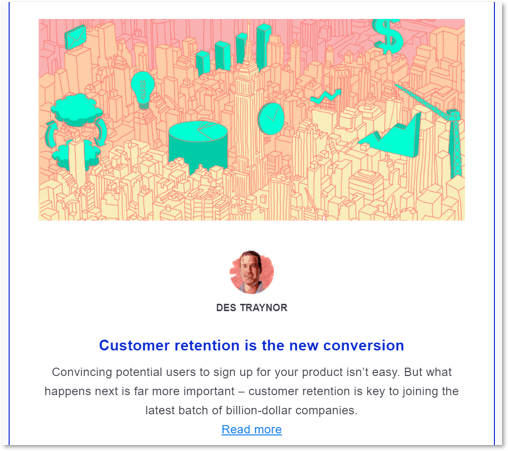
If you have multiple team members working across different marketing channels, you may need to develop an internal style guide to help guide this process. This sounds like a lot of work, but it can be as simple as committing your most common style choices to writing, like “we never use Oxford commas” and “source photos from this site only.”
5. A clear call to action
Tell your customers what you want them to do as soon as they finish reading your email. Making them guess what you want won’t help – in fact, they’ll probably just shrug and delete the message.
Use bold text, images, buttons, and links to point your customers to the intended destination. There’s no reason you should stick to a single link. By linking multiple locations in the same message, you’re making it even more likely that a customer skimming your email will see and click on that crucial call to action.
One important tip to remember: stick to a single call to action per email. If you want your new customers to review their products and return for a second purchase, you should be sending two emails. Each marketing email goal should have its own time in the spotlight or else it runs the risk of being overshadowed.
6 crucial email marketing metrics to gauge your success
There are a lot of email marketing metrics you can track. When you’re just getting started, it might be difficult to know which metrics are really important or if they’re true indicators of success. Remember, every metric should somehow feed up into your overall marketing strategy.
I recommend looking at six specific metrics to start with:
- Number of subscribers
- Deliverability rate
- Open rate
- Clickthrough rate
- Unsubscribe rate
- Conversions
While these certainly aren’t the only metrics you can track, they’re the most crucial to dig into for each campaign you send in the early and growth stages. They’ll also give you the most amount of data to act on for future messages or A/B tests.
Let’s take a look at each metric one by one.
1. Number of subscribers
This metric is simple enough. For each email you send, look at:
- How many customers were sent the email
- How many people are on your email list since the last send
You should be seeing growth in both of these areas over time, as long as you’re giving people enough opportunities to sign up for your list.
If your new subscriber count isn’t growing, take a closer look at when and where you ask people to subscribe. Could you add an email opt-in box at checkout? Does your content have calls to action to subscribe to email updates?
2. Deliverability rate
Deliverability rate is how many of your recipients are actually able to get the emails you send. Basically, if you send your email to 100 customers, but only 95 of the email addresses you have on your list work, that means you have a 95% deliverability rate.
Poor deliverability isn’t just annoying: if your deliverability rates remain low over time, you could potentially run into issues with your ISP or find yourself unable to send to entire blocks of IP addresses.
Here are some tips from Intercom’s email deliverability experts for keeping your delivery rate high:
- Don’t email disengaged users.
- Verify addresses at sign-up.
- Use confirmed opt-in to reduce spam complaints.
- Clean up your email database every 6 months.
These tips – specifically the last one – will help keep your rates high and reduce the likelihood of your messages being flagged as spam.
3. Open rate
The open rate of your emails is the percentage of customers who opened your message at least once. The average automated email sees an open rate of 20-30%, but your goal should be to get this as close to 100% as possible for any given campaign.
“The average automated email sees an open rate of 20-30%”
Increasing your open rate can be done in a few different ways:
- Experiment with timing.
- Change your frequency: if you don’t send email often, an “out of the blue” message might surprise a customer into deleting or unsubscribing.
- Personalize your subject lines, message headers and the first few lines of the email body.
- Test your subject line for common spam words.
4. Clickthrough rate
Much like the open rate, your email’s clickthrough rate is also expressed as a percentage. It tells you what percentage of the people who opened your email clicked a link.
You can look at the total clickthrough rate or the clickthrough rate for a specific link. If you have multiple links in one email, looking at individual rates may matter more to you, since it might give you some more insight into which call to action format is most successful or how many people are using your campaigns to click through to an FAQ page.
A few ideas to increase your clickthrough rates:
- Be clear about where your links go – emails aren’t the time to surprise someone!
- Make it easier to find and click links with buttons, bold text or images.
- Only use one call to action per email so customers know what you want them to do.
5. Unsubscribe rate
Your unsubscribe rate is how many of your recipients opted out of receiving your emails after receiving your most recent message. Once a customer opts out, they can’t be re-added to your list or receive emails from you again.
“Opt-outs aren’t always a bad thing”
Ideally, you want your unsubscribe rate to be as close to zero as possible for each one of your messages. But opt-outs aren’t always a bad thing; much like poor deliverability, removing customers from your list who are no longer interested can help bring up your conversion rate and improve your overall metrics.
6. Conversion rate
Finally, there’s conversion rate. Conversion rate tells you how many of the people who opened your email took a specific action after clicking a link.
A conversion might be signing up for an account, making a purchase, downloading a piece of content, or something else. This data can be tricky to find for email, especially if you’re not measuring something as straightforward as ecommerce purchases.
Luckily, you can use a tool like Google Analytics to track email conversions. Most email marketing platforms have a Google Analytics integration built-in and will handle the tagging of the links you include automatically. If your platform doesn’t integrate with Google Analytics, you can manually create special URLs to ensure Analytics receives and tracks conversion data.
Increasing your conversion rate from email often involves better personalization. The less relevant a link is to a customer, the less likely they are to click and convert. Creating email segments based on interest or activity can help you start personalizing content and ultimately increase these conversions.
Pro tip: Segment by device
It’s important to segment all of these metrics by the device type. People consume emails in drastically different ways on mobile versus desktop. Analyzing this data by device type can lead to actionable insights; for example, poor conversion on mobile may mean that your responsive email design isn’t rendering properly on mobile devices.
By making device a crucial check in your email marketing strategy – from images to email templates – you can eliminate a common cause for poor campaign performance.
Email marketing services: your best options to start with
Your email marketing strategy will depend on the service you choose and its ability to support your needs. Here are the email marketing services that I’d recommend.
These email marketing services support everything from simple campaigns to automated and segmented messaging and can work with companies as small as one person to as large as the Fortune 500.
Campaign Monitor
Campaign Monitor offers powerful segmented and personalized emails leveraging the data you already have on your customers. This capability helps you quickly set up emails that have a higher impact and a better chance at driving results than non-personalized messaging.
Its drag-and-drop email builder is beginner-friendly and allows you to create beautiful messages without the need to hire a designer or pay a developer for custom email templates. And with the Campaign Monitor integration for Intercom, websites visitors can subscribe to your list from any page on your site, right in the Intercom Messenger. You can show subscribers confirmation messages, give them access to downloadable content, or even a special offer coupon:

Mailchimp
Simple yet flexible, Mailchimp is an email marketing platform that’s built to support growing businesses. It features a drag-and-drop campaign builder, powerful segmentation, and integrations with over 300 online services.
If you’re running an ecommerce site, Mailchimp has some additional benefits: it can connect to your store to automatically send customers recommendation emails based on what they purchased in the past.
Similar to Campaign Monitor, Mailchimp’s integration with Intercom lets you capture new subscribers directly from the Intercom Messenger. You can also reward them with a discount code or downloadable content immediately after signing up.

Privy
Privy specializes in email marketing and automation for small to mid-sized ecommerce businesses. It supports abandoned cart emails for Shopify and BigCommerce stores, bringing back visitors who were on the verge of a purchase.
Additionally, Privy supports newsletters, welcome email campaigns, and coupon reminders. It also offers targeted pop-ups, exit intent messages, and on-site discount messaging.
Privy’s Intercom integration allows you to show pop-ups on your site based on user behavior, including how much time customers have spent on your site. It also supports email marketing automation based on user behavior and syncs Intercom leads to your Privy list of subscribers.
Intercom
And of course, our very own Messages product lets you send personalized, targeted messages so you can engage leads, onboard new customers, announce new features and more.
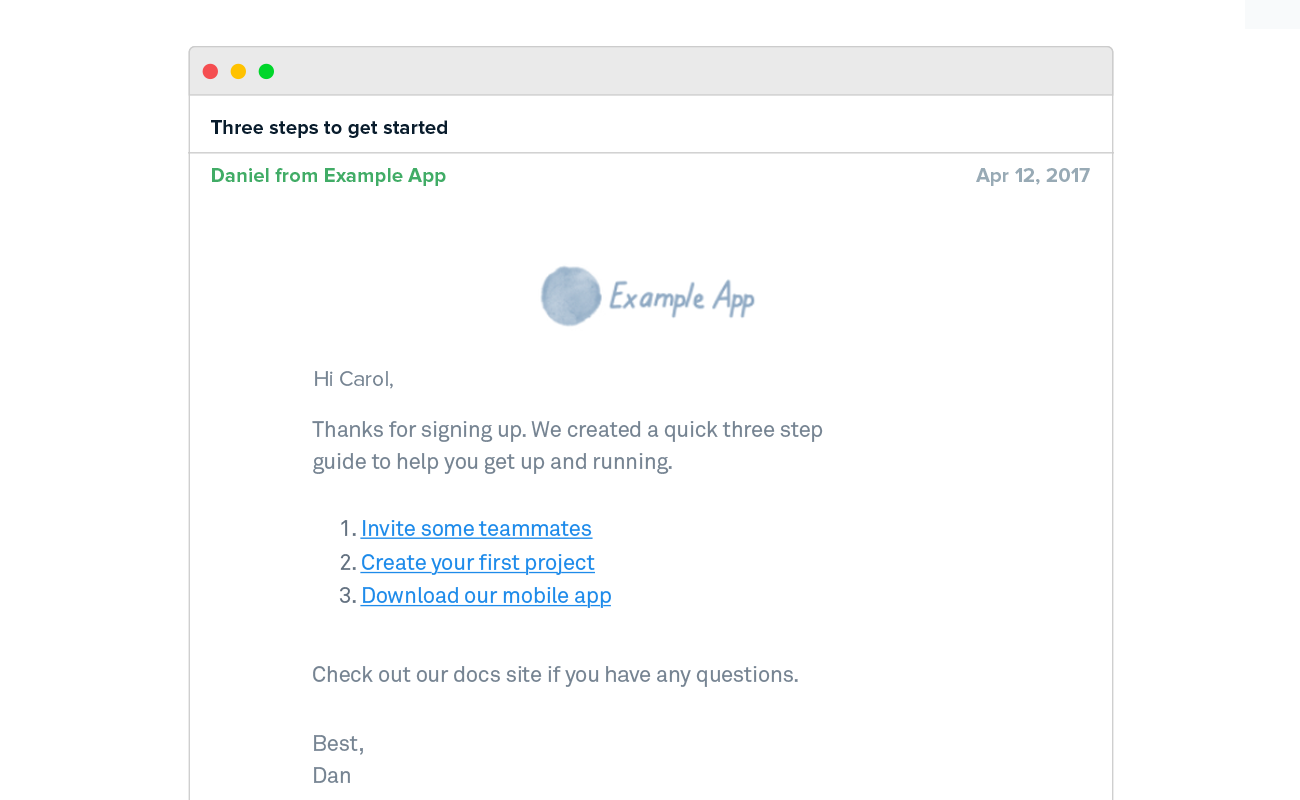
Our email features are part of a full conversational customer engagement solution designed to nurture relationships through chat, in-app messaging and email. The goal is to help you send the right message at the right place and time, and email is just one of the ways you can do that with Intercom.
All our email marketing partners
Already using Intercom for sales or support? In addition to the services listed above, we also offer integrations with Hubspot, Marketo and Salesforce.
Examples of top-notch email marketing campaigns
Sometimes the best way to get inspiration is to see what others are doing to attract and convert their own customers.
Here are some email marketing campaigns that in my opinion perfectly execute timing, personalization, and design.
Hungryroot
This lead nurturing campaign from vegan meal plan provider Hungryroot arrived at 11.07am local time, right when the recipient might start daydreaming about lunch.
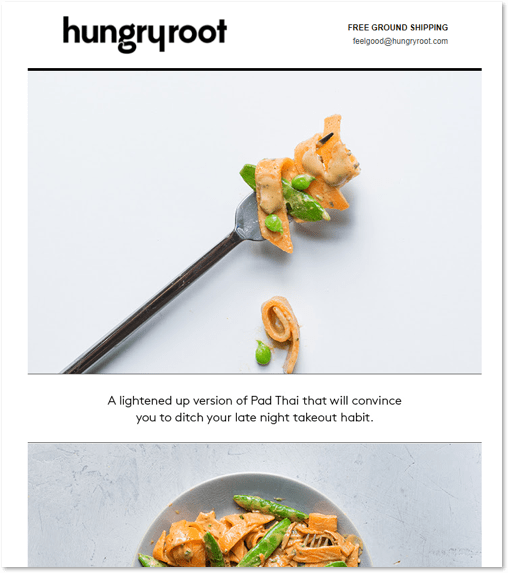
Along with the timing, what really makes this message successful are its gorgeous photographs of great-looking meals and the motivating subject line about ditching takeout: “Ditch your takeout habit with our Sweet Potato Pad Thai”
The email ends with a coupon to save $20 and get free shipping, which is another motivator to get started with a (sometimes costly) meal plan.
Scott’s Cheap Flights
Does your product or service have upgrades you’re trying to convince customers to try? You might want to try a separate email for it, like Scott’s Cheap Flights did here.

This is a great example of personalized messaging and on-brand design. This email is only sent to free users, who receive occasional emails about unusually cheap flights. It’s designed to upgrade them to a premium version of the service with more flight deals sent more frequently. The simple design of this message and its casual, conversational copy match the tone and voice of the copy on the website.
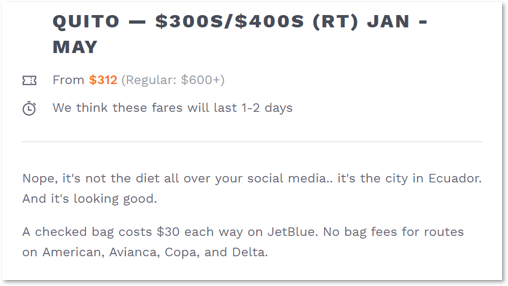
Wistia
Have you ever felt like a company really cared about your success? Wistia, a video hosting platform, uses automated emails to alert customers when they publish a new guide.
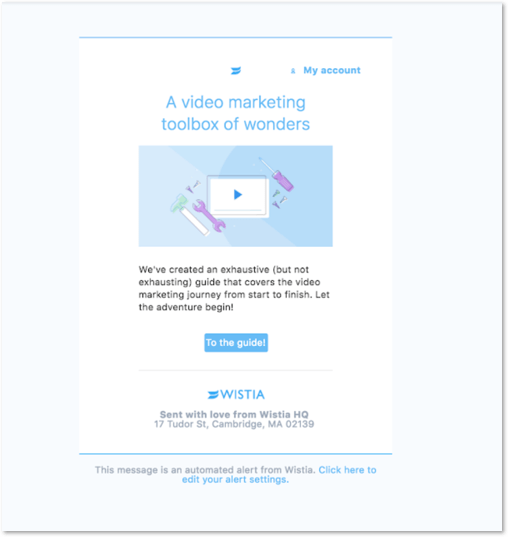
There are no upsells, mentions of plans, or even new features advertised in this email. It’s a simple link to a guide created to help their customers promote their videos. You’re left with the feeling that Wistia cares about your success – why else would they send you such helpful content?
Also, like the Scott’s Cheap Flights email above, Wistia’s light and friendly tone is evident throughout this message. The footer even says the email is “sent with love” – a small detail that really adds a nice touch to a message that already makes you feel good about working with them.
Asana
Not all marketing is about purchases. Many SaaS companies focus the majority of their email efforts on retaining and re-activating users since churn can have such a big impact on their revenue.
This email from Asana is a great example of an email designed to keep customers engaged. Sent as part of a “new user” drip campaign, the opening line immediately catches the attention of a busy worker: “Make meetings more productive.”

The goal with this message is to show a customer a new way to use Asana that they might not yet have explored. At this point, they may have only made a to-do list or two – but with this email, they’re able to gain a better understanding of how the service can have a long-term impact on their day and career.
H&R Block
Some re-activation emails require you to ask yourself, “When will marketing have the biggest impact on the customers I haven’t seen in a while?”
If you don’t have anything new to share or it’s not the right time of the year, a re-activation campaign runs the risk of being ignored. But this message from tax preparation company H&R Block arrived in mid-January – right around the time that United States residents start to receive W2 forms and think about tax returns.
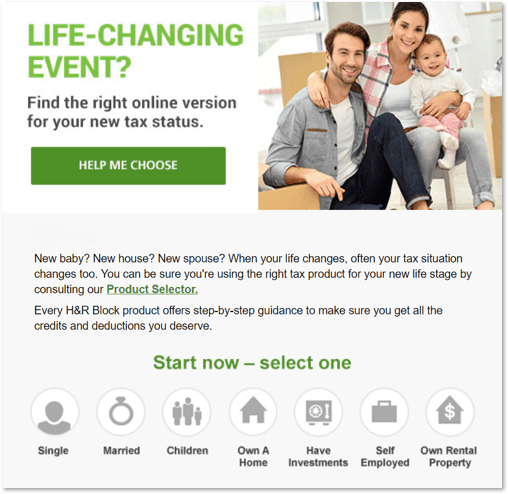
This message, sent to previous H&R Block users, asks former customers if the tax software they’ve used in the past is right for them. Clicking the call to action walks customers through a guide to picking the most suitable version of H&R Block.
This email makes customers feel empowered. By helping them choose their tax software before they even start filing a return, they’ll feel prepared for the arrival of their tax forms. They’ll also be all set up to use H&R Block in just a few clicks, which is easy for them . . . and exactly what the email intended.
Start improving your customer relationships with email
Ultimately, great email marketing campaigns are the result of knowing what your customers need, sending them messages at the right time and monitoring the results to improve what you do next.
Using the best email practices above, you can make email marketing an effective tactic for creating and nurturing customer relationships long-term.






